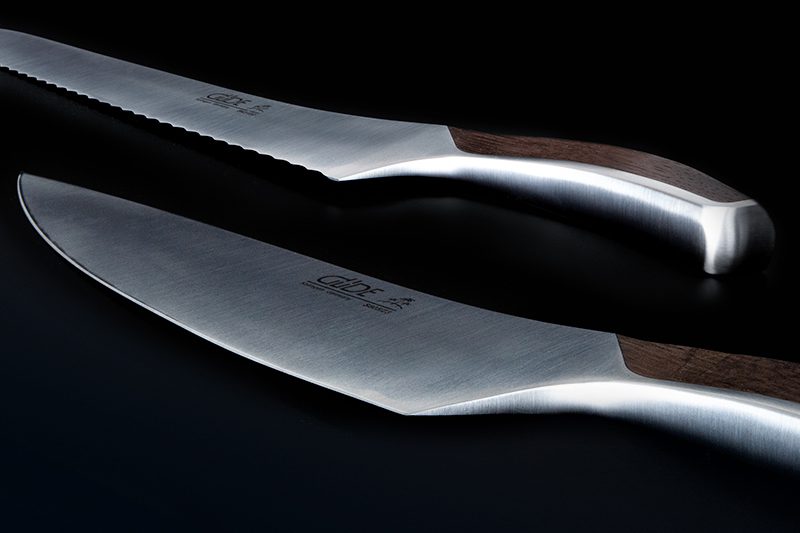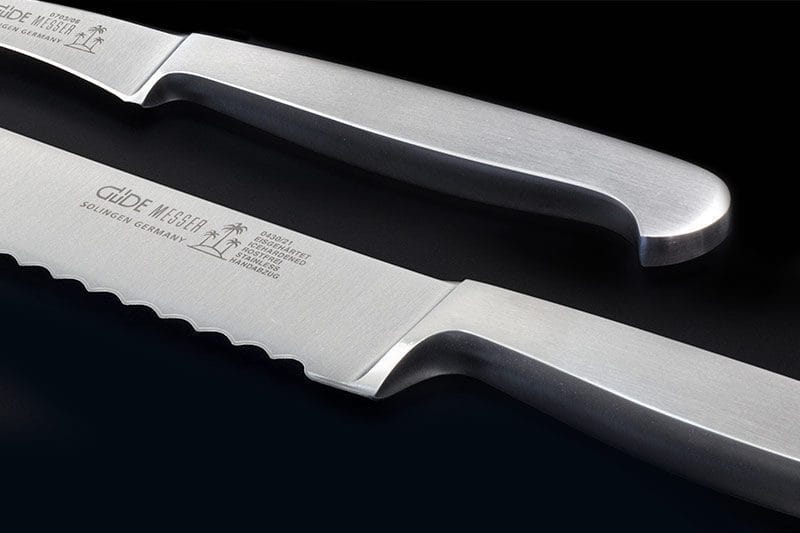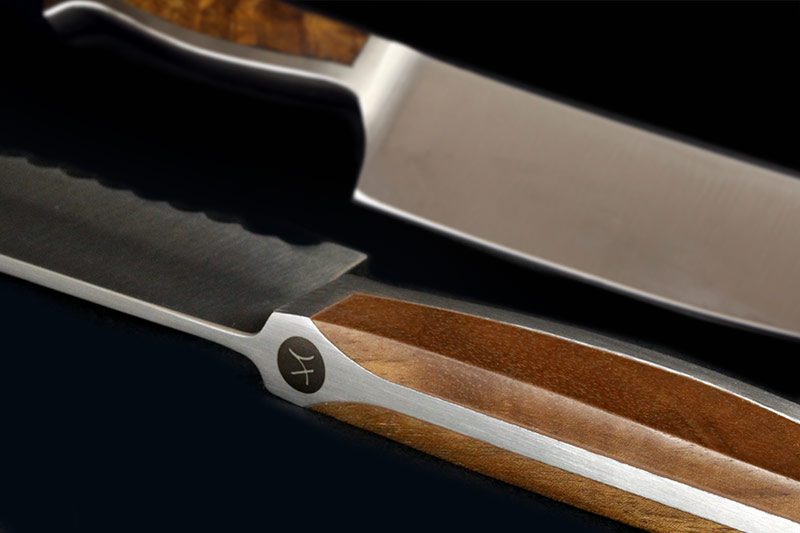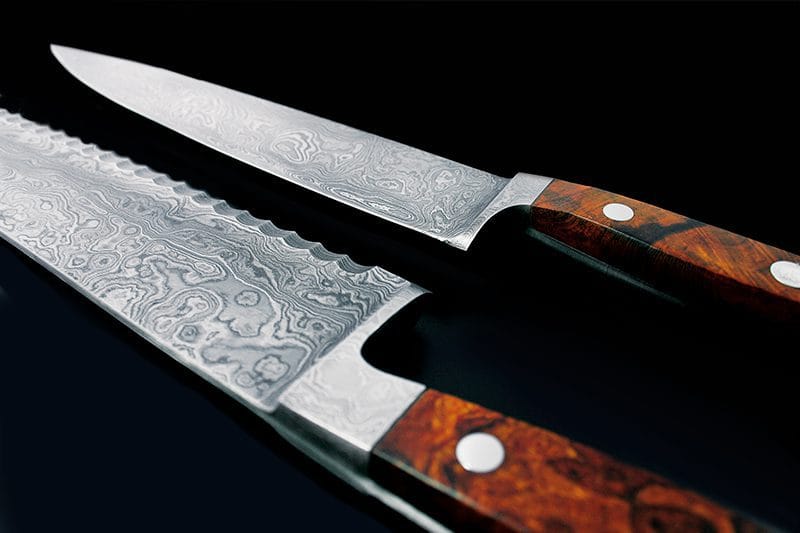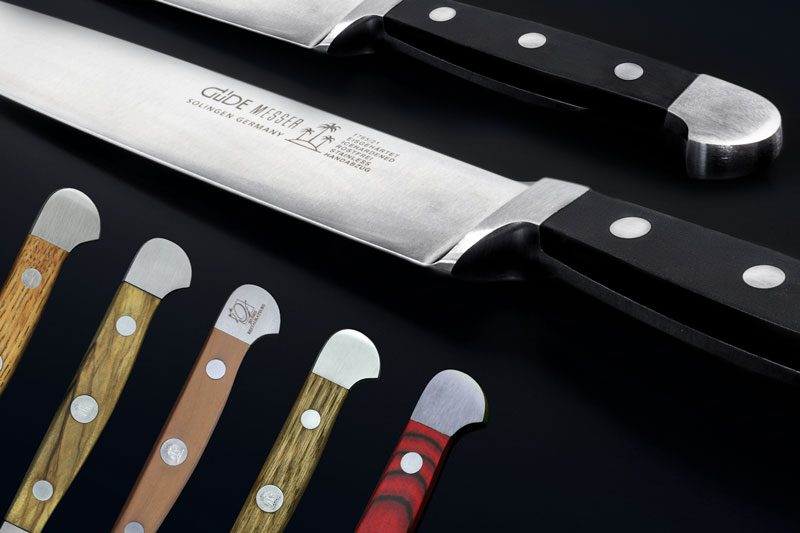THE KNIFE.
We've kept a close eye on the chefs and completely reinvented the chef's knife with THE KNIFE. Everything about this knife is really different. The short handle automatically lets the user grip the knife much further forward than normal. So far forward that the thumb and index finger enclose the blade. The blade becomes an (almost) natural extension of the hand. A secure grip and precise guidance are guaranteed. The hand automatically sits above the blade and not behind it. This ensures a shorter lever and thus better power transmission. No transition interferes, all lines are flowing. And then this blade, ground through to the end and extended backwards to below the handle. Cutting where the force is, supported by a weight distribution that THE KNIFE. virtually drops into the material to be cut. More is hardly possible. With the GOOD DESIGN Award, THE KNIFE. received the oldest, most prestigious and globally recognised prize for excellent design - in addition to a host of other renowned awards. By the way: cooking with THE KNIFE is actually even more beautiful than just looking at it!

Material
The blade material of knives must sometimes fulfil contradictory requirements. It is therefore crucial to weigh up the different requirements and ensure an optimum. On the one hand, the knife steel should be hard, but not too hard, otherwise there is a risk that the blade will break under heavy use. On the other hand, however, the knife steel should not be too soft either, as ongoing wear and tear would cause the knife to lose its sharpness too quickly during use. That is why THE KNIFE. from GÜDE is made of a chrome-molybdenum-vanadium knife steel. This steel perfectly fulfils the sometimes contradictory requirements with an optimum hardness of approx. 57-58 HRc (Rockwell).
THE KNIFE . is available in many different designs: Whether damascus or carbon or classic blade steel, whether handles made of olive, oak or grenadilla - all the way to the limited special edition with a handle made of New Zealand jade to celebrate the 111th anniversary of the manufactory GÜDE.
The hardness of the classic GÜDE blade steel of 57-58 HRc is not too hard and not too soft for the different requirements that a good knife must meet.
Such a degree of hardness makes the blade torsionally stiff, thus guaranteeing a more precise guidance of the knife and thus a more precise cut. But even a hard steel, such as GÜDE knife steel, can be ground very thin. In this way, even a hard steel can be very flexible.
Production
THE KNIFE. is also traditionally drop-forged - from one piece of steel. The result of this traditional technology of drop forging is a particularly high material strength even when the knife is subjected to dynamic stresses. During the forging process, the entire forging blank is heated in the die until it glows red and is then deformed between the two dies, the upper and lower die. In further detail-oriented manual work steps, the drop-forged blank is turned into an innovative one-of-a-kind knife from the knife manufactory GÜDE - handmade.
After forging in the die, the knives are stamped out of the forging blank and then roughly ground, calibrated and cleaned. This is followed by so-called ice-hardening: the knives are cooled to -80 °C to improve the structure of the microstructure in the blade steel. In the next step, the knives are tempered in two stages. Tempering is a term used by the knife makers in Solingen. Tempering means that the knife is heated again and thus made unbreakable. Now the blade is pre-ground. This is followed by the pre-grinding of the back of the knife, which is the upper part of the knife. This is followed by the fine grinding of the back of the knife and the grinding of the transition between the blade and the handle. The back of the blade is now pre-ground for the attachment of the handle and provided with retaining bars. Then the blade is fine-ground. The Solingen knifemaker also calls this "pliesten". This gives the blade its distinctive surface. The handle is now placed on the retaining bars, glued and adjusted. Another five or so work steps are required to adjust the handle and blade so that the transitions between wood and steel are smooth. These five steps must then be repeated with a finer abrasive belt. Now the upper part of the knife, the back, gets its fine grinding. This is followed by the finest grinding of the flowing transition between the blade and the handle. Then the knife handles are pre-polished, followed by fine polishing. Only now does the knife get its sharpness trigger, because the knife edge, also called the bevel, is now sharpened (the knifemaker calls this "honing"). The trigger is polished so that the blade slides better through the material to be cut. In the next step, the GÜDE logo is etched onto the blade. Cleaning and quality control are the final operations. After that, the knives are sheathed for protection. Last but not least, the knives are packed in a gift box with the GÜDE pit cloth and the appropriate labels are applied. The finished knives are now stored and ready for shipping.
Form
The technology of forging in the die creates degrees of freedom in the design language. From the end of the handle to the tip of the knife, shapes can be created that would not be possible with any other forging technology. For example, the innovative design language with the flowing transition from handle to blade from THE KNIFE. is only possible in the drop forging process. This explains impressively why GÜDE has remained faithful to this proven and traditional technology for four generations since its founding in 1910.
THE KNIFE . deliberately dispenses with the so-called "bolster", the thickening between the blade and the handle, which for a long time was considered a typical feature of forged knives. The seamless transition from the handle to the blade of THE KNIFE. creates a completely new haptic and functional experience - an innovation of the knife manufacturer GÜDE.
Just like a professional chef holds a chef's knife, you hold THE KNIFE. quite automatically. The thumb and index finger form a U and securely grip the blade. The middle finger is comfortably "parked" in the finely crafted bulge at the end of the blade. This keeps the centre of gravity perfectly inside the hand and ensures fatigue-free work.
THE KNIFE . does without the so-called tang. This is because the short handle automatically allows the user to grip the knife much further forward than normal. So far forward that the thumb and index finger enclose the blade. The blade becomes an (almost) natural extension of the hand.
Function
A good knife should not only be sharp, it should also stay sharp for as long as possible. A good knife should also lie well in the hand and be balanced so that fatigue-free and safe work is guaranteed at all times.
Sharpness and edge retention of THE KNIFE. are ensured both by the optimum hardness of the GÜDE blade steel with approx. 57-58 HRc (Rockwell) and by the GÜDE bevel angle of approx. 33 degrees. In addition, the blade of THE KNIFE. is ground through to the beard, which is also predestined for Asian cuisine.
The innovative shape of the handle allows the user to grip the knife much further forward than normal - as professional chefs do - in the so-called "over-handle". In addition, the wide blade guarantees optimum use of force and at the same time a safe distance from the cutting board.
Sharpness and edge retention are determined not only by the blade material but also by the bevel angle: cutting is like driving a wedge through a material to be cut. The more acute the angle of the wedge, i.e. the bevel angle, the easier it is to drive the wedge through the material to be cut. The term "bevel" is the knifemakers' term for the cutting edge, i.e. the sharply ground part of a knife. A sharp bevel angle makes a knife sharper than a blunt bevel angle.
If the bevel angle is too acute, however, the bevel can break. That is why THE KNIFE. from GÜDE has an optimum bevel angle of approx. 33 degrees. This angle guarantees both sharpness and stability.
The chrome-molybdenum-vanadium blade steel of THE KNIFE. with its hardness of approx. 57-58 HRc (Rockwell) guarantees long-lasting sharpness. It is important to always cut on a suitable cutting surface, e.g. wood or plastic.
Due to the automatic "over-handle" the centre of gravity is inside the hand. More balance is not possible! For the user this means: Perfect balance and fatigue-free work with a secure grip at all times. THE KNIFE becomes an (almost) natural extension of the hand.
The wide blade of "THE KNIFE." offers a safe distance to the cutting board, as the fingers are placed far away from the cutting edge. The unusual blade is equally suitable for Western and Asian cuisine. Because the continuous grind of the approx. 26 cm long blade all the way to the rear end offers all the functionalities of a Japanese Santoku knife. Thanks to its consistently crowned shape, the cradle cut is perfect.
The innovative geometry of "THE KNIFE." guarantees optimal grip, optimal guidance, optimal safety and an optimal cutting result - for the long term!
Watch product video
With the optimally balanced kitchen knife THE KNIFE. a vertical flow of forces is guaranteed! Precise and with the highest possible safety, every cutting task in the kitchen is a success. Watch the product video now and be convinced!
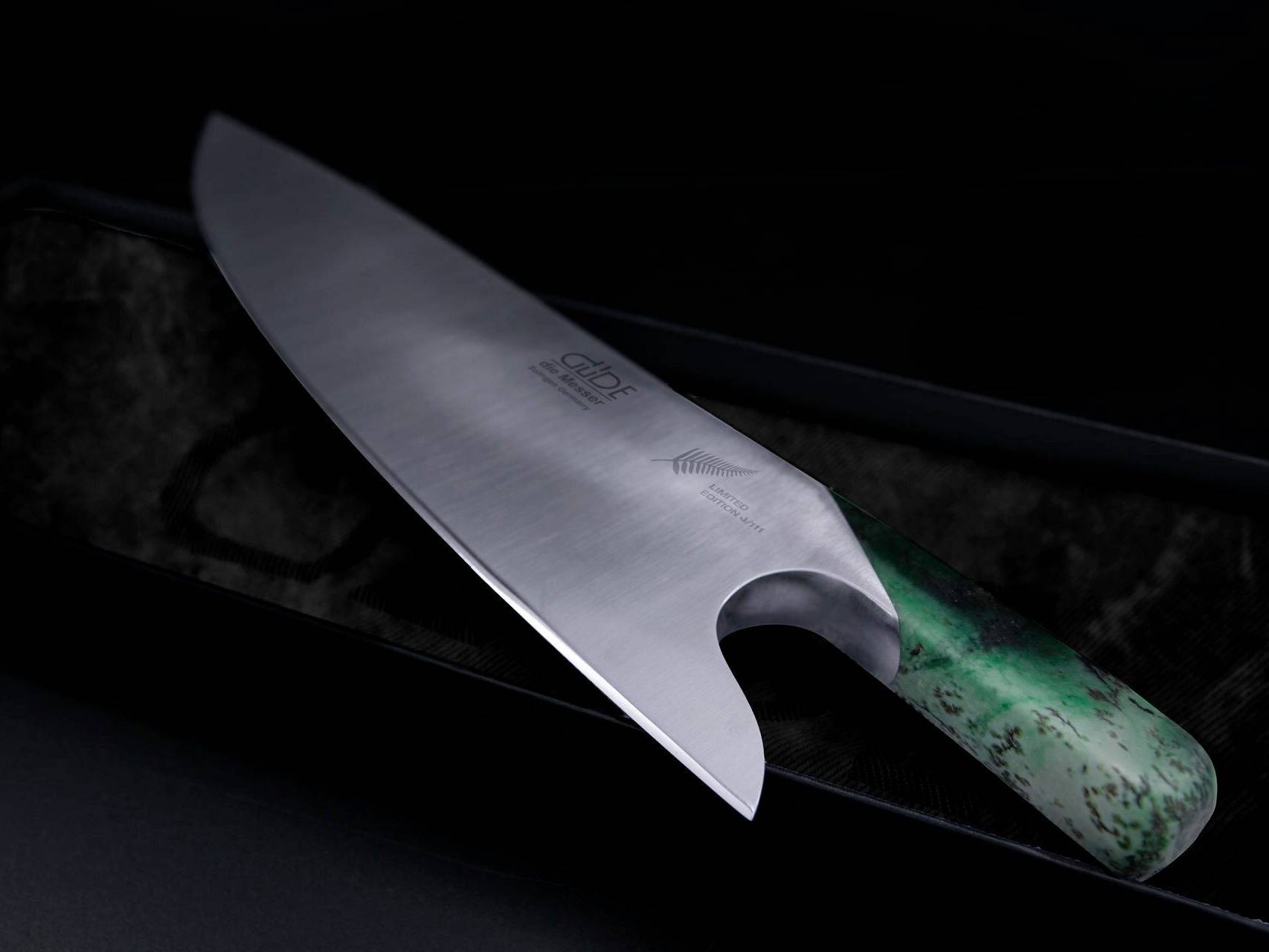
The Knife. Discover Jade
The art of forging from Solingen and the art of jewellery from New Zealand united: this combination results in the breathtaking THE KNIFE. Jade! Secure the limited special edition for the 111th anniversary now and cook in style!









